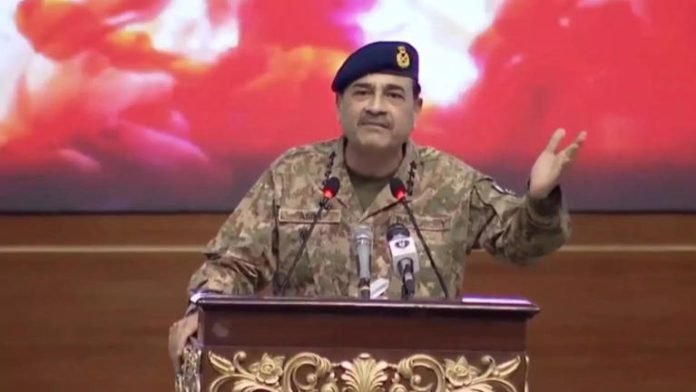Field Marshal Munir’s address at the Pakistan Military Academy in Kakul was not a strategy, it was a cry for relevance. A general speaking not to India but to a fractured institution that has lost confidence in itself. The very place that once sheltered Osama bin Laden now shelters denial.
Munir’s words were not doctrine; they were damage control. His tone, a mix of defiance and despair, tried to paint humiliation as resistance. Every sentence was an admission that Pakistan’s military machine is running on bluster, not capability.
The truth is undeniable: Pakistan’s military posturing hides deep operational failure and a broken deterrence myth. Every claim he made is either exaggerated, irrelevant, or directly contradicted by the defeat during Operation Sindoor and the embarrassment from Tehreek-e Taliban Pakistan (TTP) recently. In his speech he made several unsubstantiated claims, only to assuage the hurt ego of his soldiers, like;
Claim 1: India’s “geographical immunity” can be shattered
Munir warned that India’s geography no longer guarantees safety. In reality, Operation Sindoor demonstrated the opposite. India controlled the pace and space of the conflict, mobilising rapidly and striking with precision while operating within its own territory. Pakistani forward positions, airbases, and communication hubs were neutralised without India exposing itself to a serious threat. Geography, reinforced by strategy and readiness, remains a fundamental advantage for India. Munir’s claim is a reflection of Pakistan’s inability to penetrate Indian defences, not a signal of vulnerability.
Munir’s words were not doctrine; they were damage control. His tone, a mix of defiance and despair, tried to paint humiliation as resistance. Every sentence was an admission that Pakistan’s military machine is running on bluster, not capability
Claim 2: Even a “minor provocation” will invite a “decisive, beyond proportions” response
Munir framed Pakistan as capable of disproportionate escalation in response to the smallest Indian action. In reality, Operation Sindoor proved the opposite. Pakistan’s conventional forces were pinned, its airbases and communication nodes systematically disabled, and its tactical nuclear systems remained bunker-bound and untested. The so-called “decisive response” never materialised. By emphasising this hypothetical retaliation, Munir is admitting that Pakistan relies more on threats than on actual warfighting ability. Operation Sindoor demonstrated clearly: India can act decisively without triggering the catastrophic escalation, which Pakistan advertises.
Claim 3: The nuclearised environment constrains war
Munir emphasised that nuclear weapons constrain conflict, yet he simultaneously threatened “beyond proportion” retaliation. The contradiction is stark. India’s Operation Sindoor showed that nuclear arsenals are irrelevant if one side can achieve rapid, surgical outcomes. Pakistan’s bluff was called; the presence of its nuclear weapons did not prevent India from striking decisively. Munir’s words, intended as deterrence, reflect strategic anxiety more than strength.
Claim 4: Combat and communication zones have no distinction
Munir claimed Pakistan could strike across operational depth with impunity. The reality of Operation Sindoor contradicts this. Indian cyber and electronic warfare operations disabled Pakistani communications, leaving units isolated and uncoordinated. Far from blurring the lines, India controlled the operational space and tempo. Munir’s boast of strategic reach is nothing more than a rhetorical shield over tangible weakness.
Munir warned that India’s geography no longer guarantees safety. In reality, Operation Sindoor demonstrated the opposite. India controlled the pace and space of the conflict, mobilising rapidly and striking with precision while operating within its own territory. Pakistani forward positions, airbases, and communication hubs were neutralised without India exposing itself to a serious threat
Claim 5: India would bear responsibility for escalation
Munir repeatedly insisted that any conflict would be India’s fault. A statement which stems from the guilt of proxy war and abetting terrorism. The nightmare of Operation Sindoor still haunts the Pakistani Chief, which was triggered by Pakistan and brought it to its knees, begging for a ceasefire. The recent statements by the Indian polity and military have weakened Pakistan Army Chief’s knees, and he had to read a script. By shifting blame, Munir is ignoring the role of the Pakistan military as a state within the state, now begging the US with a bowl of rare minerals. A new low in the history of military respect and repute. This is not deterrence but denial with an ostrich outlook.
Claim 6: Pakistan can inflict “deeply hurting military and economic losses”
Munir implied that Pakistan could impose costs disproportionate to Indian action. Reality disagrees. During Operation Sindoor, India’s strikes disrupted Pakistan’s key military infrastructure, degraded its airpower, and neutralised its tactical advantages within hours. Pakistan’s economy and logistics—already stressed—were vulnerable to further disruption. The claim of inflicting deep losses is aspirational at best. Pakistan’s military hierarchy knows it cannot translate rhetoric into actionable damage without exposing itself to catastrophic countermeasures. Munir’s boast is aspirational bravado, not operational fact.
Claim 7: Pakistan’s retaliation would be “beyond expectations”
The most revealing part of Munir’s speech is this insistence on retaliation exceeding Indian expectations. Pakistan could not meet such promises during Operation Sindoor. Its formations were scattered, its air defence ineffective, and its leadership paralysed by the rapid Indian response. There was no “unexpected retaliation,” only confusion, denial, and internal panic. Munir’s statement is aspirational theatre intended to reassure his own ranks after their operational inadequacy was exposed.
Munir emphasised that nuclear weapons constrain conflict, yet he simultaneously threatened “beyond proportion” retaliation. The contradiction is stark. India’s Operation Sindoor showed that nuclear arsenals are irrelevant if one side can achieve rapid, surgical outcomes
The Subtext: Frustration and Insecurity
While Munir’s word-for-word read speech was intended as a warning, it communicates something very different to New Delhi: Pakistan’s panic and insecurity. The speech is a psychological exercise designed to bolster morale within a military establishment that saw humiliation in the eyes of the nation. Nuclear sabre-rattling, exaggerated claims of reach, and invented inevitability of retaliation are Munir’s way of telling his own people that Pakistan still has teeth, using US-made dentures, despite repeated evidence of failure and defeat.
Overall, Munir’s speech was not a message of deterrence; it was a confession of defeat. Every claim he made, collapsed by evidence of Operation Sindoor and the recent TTP strikes. Behind the talk of retaliation lies a military stripped of initiative, struggling to look formidable after being exposed as fragile. This was not leadership; it was theatre for survival. Pakistan’s deterrence is a myth, and its Army Chief’s words echo the frustration of a military that has lost capability, credibility, and control. In the end, the mask slipped. What remains is the noise of denial.
In the words of Abraham Lincoln, “You can fool some of the people all of the time, and all of the people some of the time, but you cannot fool all of the people all of the time.”
The author, a PVSM, AVSM, VSM has had an illustrious career spanning nearly four decades. A distinguished Armoured Corps officer, he has served in various prestigious staff and command appointments including Commander Independent Armoured Brigade, ADG PP, GOC Armoured Division and GOC Strike 1. The officer retired as DG Mechanised Forces in December 2017 during which he was the architect to initiate process for reintroduction of Light Tank and Chairman on the study on C5ISR for Indian Army. Subsequently he was Consultant MoD/OFB from 2018 to 2020. He is also a reputed defence analyst, a motivational speaker and prolific writer on matters of military, defence technology and national security. The views expressed are personal and do not necessarily carry the views of Raksha Anirveda






